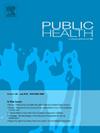英国生物库中成年癌症患者的社会经济地位和营养不良与生存的关系:前瞻性队列研究
IF 3.9
3区 医学
Q1 PUBLIC, ENVIRONMENTAL & OCCUPATIONAL HEALTH
引用次数: 0
摘要
社会经济差异和营养不良是全球健康挑战的重要因素,但社会经济地位(SES)与营养不良之间的关系以及癌症患者随后的死亡风险仍未得到充分探讨。本研究旨在探讨社会经济地位、营养状况与癌症患者全因死亡率和癌症特异性死亡率之间的复杂关系。研究设计前瞻性队列研究。方法纳入来自英国生物银行(UK Biobank)的基线评估前两年内诊断为癌症的参与者(n = 4216, 47.3%为男性)。采用潜在分类分析(LCA)和全球营养不良领导倡议(GLIM)标准评估患者的SES和营养状况。采用Logistic回归评估社会经济地位与营养状况之间的关系。cox比例风险模型,以及中介、联合关联和相互作用分析,建立了社会经济地位、营养状况、全因死亡率和癌症特异性死亡率之间的关系。结果在15.14 (IQR: 15.09-15.20)年的中位随访期间,1039名参与者死亡,其中788例死亡是癌症特异性的。社会经济地位低的参与者(与社会经济地位高的相比)营养不良(OR 1.60, 95% CI 1.08-2.39)和全因死亡率(HR 1.22, 95% CI 1.03-1.44)的风险增加。在低社会经济地位和全因死亡率之间的关联中,营养不良占6.8%。与营养良好的高SES患者相比,营养不良和低SES患者的全因死亡率风险最高(3.12,2.26-4.29),而营养不良和高SES患者的癌症特异性死亡率风险最高(2.88,1.97-4.21)。结论:虽然仅解决营养不良问题可能无法显著减少社会经济差异造成的死亡率差异,但它仍然是减轻癌症负担的关键策略,特别是在低社会经济地位的患者中。本文章由计算机程序翻译,如有差异,请以英文原文为准。
Associations of socioeconomic status and malnutrition with survival in adults with cancer in the UK Biobank: A prospective cohort study
Objectives
Socioeconomic disparities and malnutrition are significant contributors to global health challenges, yet the relationship between socioeconomic status (SES) and malnutrition, and the subsequent risk of mortality in cancer patients remains underexplored. This study aimed to investigate the complex relationships between SES, nutritional status, and both all-cause and cancer-specific mortality in cancer patients.
Study design
Prospective cohort study.
Methods
Participants from the UK Biobank with a cancer diagnosis within two years prior to baseline assessment were included (n = 4216, 47.3 % male). Latent class analysis (LCA) and the Global Leadership Initiative on Malnutrition (GLIM) criteria were employed to evaluate patients’ SES and nutritional status. Logistic regression was applied to assess the associations between SES and nutritional status. Cox-proportional hazards models, along with mediation, joint association, and interaction analyses, were done to establish the relationship between SES, nutritional status, and both all-cause and cancer-specific mortality.
Results
During a median follow-up of 15.14 (IQR: 15.09–15.20) years, 1039 participants died, of which 788 deaths were cancer-specific. Participants with low SES (vs high) had an increased risk of malnutrition (OR 1.60, 95 % CI 1.08–2.39) and all-cause mortality (HR 1.22, 95 % CI 1.03–1.44). Malnutrition accounted for 6.8 % of the association between low SES and all-cause mortality. Compared to well-nourished patients with high SES, those with malnutrition and low SES had the highest risk of all-cause mortality (3.12, 2.26–4.29), while those with malnutrition and high SES faced the highest risk of cancer-specific mortality (2.88, 1.97–4.21).
Conclusions
While addressing malnutrition alone may not significantly reduce mortality disparities arising from socioeconomic differences, it remains a crucial strategy for alleviating cancer burden, especially among patients with low SES.
求助全文
通过发布文献求助,成功后即可免费获取论文全文。
去求助
来源期刊

Public Health
医学-公共卫生、环境卫生与职业卫生
CiteScore
7.60
自引率
0.00%
发文量
280
审稿时长
37 days
期刊介绍:
Public Health is an international, multidisciplinary peer-reviewed journal. It publishes original papers, reviews and short reports on all aspects of the science, philosophy, and practice of public health.
 求助内容:
求助内容: 应助结果提醒方式:
应助结果提醒方式:


